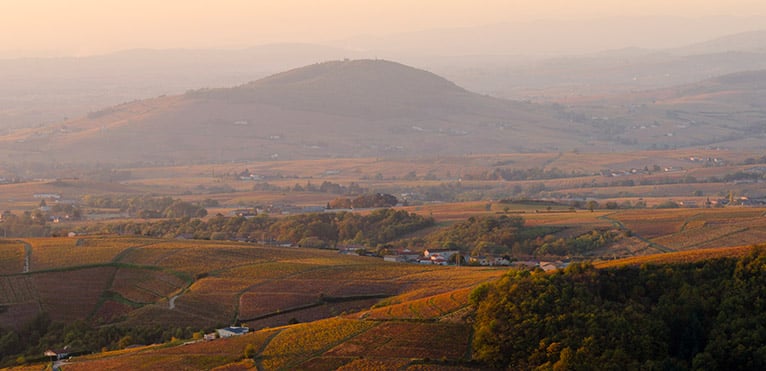
Contents
Brouilly is a wine appellation in the Beaujolais region. This region, which lies north of Lyon, extends to the south of the Saône-et-Loire department and certain municipalities in the Rhône department. One of the region’s twelve Protected Designations of Origin (AOC), the Brouilly vineyard produces almost exclusively red wine from the Gamay grape, as well as a few whites from the Chardonnay grape.
The history of the Brouilly vineyards is rich and marked by the Romans
It was the Romans who first developed viticulture at the foot of Mont Brouilly. Legend has it that the name of this hill, which inspired the appellation, comes from a Roman officer named Brulius.
The Brouilly and Côte-de-Brouilly crus were one and the same at the beginning of the century, but were separated in 1938 and now each has its own appellation. With a surface area of 1,393 hectares, the Brouilly cru is the largest and most Mediterranean of the Beaujolais crus (the other crus are Chiroubles, Chénas, Juliénas, Fleurie, Moulin à vent, Morgon, Saint-Amour and Régnié).
The Brouilly vineyard is one of the largest in Beaujolais.
The Brouilly vineyard represents a vast area, with varied soils, surrounding the “Brouilly mountain” around the municipalities of Quincié, Cercié, Saint-Lager, Odenas, Charentay and Saint-Étienne-la-Varenne. The Monts du Beaujolais border the Beaujolais vineyards to the west, and the Saône River to the east. The Beaujolais-Villages vineyards are located on 1,393 hectares of vines on the slopes of the Monts du Beaujolais, rising to 700 m or sometimes over 1,000 m. Sheltered by the Massif Central, it is only slightly affected by Mediterranean disturbances. The Brouilly vineyard represents the largest production area (around 20% of the total surface area) and the most southerly of the ten Beaujolais crus appellations.
The climate of the Brouilly vineyards is similar to that of the Beaujolais region. it enjoys a temperate, semi-continental climate. This terroir is composed of several different soils to the east, south and west: gravelly soil on low-acid rock; siliceous clay-limestone soil; and pink soil on a granitic base. In places, there are also abundant soils with fragments of weathered rock. In particular, the Brouilly vineyards have granitic and clay-limestone soils that guarantee good wine structure. The earth is stony and rather poor which provides the wine body and structure. In contrast to Pinot Noir, the best Gamay wines are produced on acidic, granitic soils.
Brouilly is a delicious, gourmet wine
Brouilly, like the 9 other Beaujolais crus, offers a beautiful and singular expression of the Gamay grape variety. Its particular terroir gives the wine a deep, complex profile. The Brouilly vineyard produces mainly red wines, with a few whites and rosés. The grape variety used for Brouilly wines is Gamay noir à jus blanc (98%) for red and rosé, and Chardonnay (2%) for white.
Brouilly wines are characterized by their beautiful purple color. On the nose, this wine evokes red fruits and flowers such as violets and peonies. On the palate, Brouilly is full of finesse and roundness. This is indeed a wine rather vinous and quite fruity, which delivers from its earliest youth. Brouilly is a wine to be enjoyed young, with an ageing potential of 2 to 4 years. However, it should be noted that the ageing potential of this Beaujolais cru varies according to the estate from which it comes and its vinification.
Brouilly generally goes well with charcuterie.
Gouleyant, fruity and bursting with youth, wines from the Brouilly appellation go wonderfully well with a wide range of dishes. For example, duck, poultry, beef tartare, simmered lamb, capon with forestry sauce, fine charcuterie, or soft cheeses… More generally, it’s a question of the right ingredients.a wine traditionally served with charcuterie, but which can also be served as a simpleaperitif. Brouilly wines should be drunk at 14°.
Exceptional AOC Brouilly vintages
1929, 1937, 1959, 2005, 2009 and 2011 were the best vintages for the Brouilly appellation.. This is known as the millennium vintage. The years 1928, 1945, 1971 and 1976 produced exceptional vintages.
Historic estates in the Brouilly vineyards
Domaine Piron
Dominique Piron is the current manager of this 14-generation family estate. In fact, since 1590, the family business has been steadily strengthening its know-how and passion for vines. Today, they cover almost 50 hectares and are maintained using environmentally-friendly methods and traditional cultivation methods. The winegrowers at this estate have no shortage of ambition: their aim is to expand their winegrowing estate by purchasing new terroirs and increasing their production capacity and workforce!
Château De La Terrière
This Brouilly winemaker is located in the heart of historic Beaujolais, in Cercié, facing Mont Brouilly. It dates back to the 15thèmeThis is one of the oldest estates in the region, and one of its special features is that it was founded on Roman remains! Today, the estate covers 28 hectares, 12 of which are dedicated to the production of Cru Brouilly.
Fleurie, Moulin à Vent and Pinot noir are also appellations produced by this winery. It’s a family-run winery in that Grégory Barbet, the current château manager, represents the 9th generation of the family.th generation of this winegrowing family.